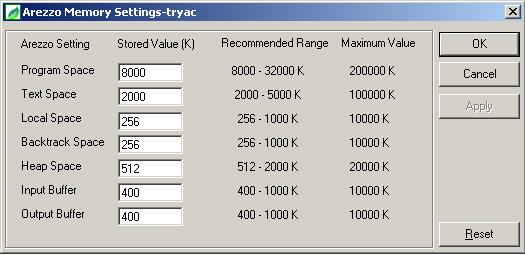
To set the Arezzo memory settings for a study, open the study and select File > Arezzo Memory Settings.
This window allows you to adjust the various memory areas used by the Arezzo toolkit when processing your study definition and when handling subject data in the Data Entry/Review module. If you do not set any memory values, the Arezzo toolkit uses default memory settings, but if your study contains a particularly large number of questions, eForms or visits, or if your subject data files contain many cycling eForms or visits, then you may need to increase the memory allocated to Arezzo. You should increase the relevant memory area if you see Arezzo memory errors whilst testing your study.
You can set different memory values for each study and each study's Arezzo memory settings are stored with the study definition in the master database. However, if you have several studies in one database, the actual memory settings that will be used are the maximum values for any study in the database. So if you have one large study in a database, with high memory settings, these settings will be used for any study which is loaded from that database.
The Arezzo Memory window contains four columns. See image
|
Arezzo Setting |
This is the name of the memory area. Arezzo has several memory areas, each used for different parts of its processing. See below for an explanation of each. |
|
Stored Value (K) |
This is the current size of the memory area, in kilobytes, and it is these values that you can adjust. |
|
Recommended Range |
This is the suggested range of values, which is a rough guide to what might be normal values. |
|
Maximum Value |
This is the highest value you can enter for each field. |
Note: You will need to reopen a study before any new memory settings take effect.
Program space is used to store the definition of your study, including all the questions, eForms and visits, and it is also used to store a subject’s response values during Data Entry. You may find that program space runs out when a particularly large number of eForms is entered during data entry.
Text space is used to store all the text terms contained in your study, acting as a kind of dictionary. You will need to increase your text space if you have a lot of questions defined, or you have a lot of text strings in your validation messages, or if you have a large number of category values, for example.
Local space, Backtrack space and Heap space are Arezzo’s ”work spaces” which are only used as temporary storage areas whilst Arezzo is processing. It is rare to have to alter these values, but it may be necessary to increase them if you have any particularly long or complex derivations or validation conditions.
Input and Output buffer are used for communication between MACRO and Arezzo, and may occasionally need to be increased for large study definitions or large numbers of questions or subject data responses.
There are no hard and fast rules for determining what Arezzo’s memory settings should be. It varies according to the number of questions, eForm and visits defined, the number and complexity of the derivation and validation expressions defined, and the number of responses, eForms and visits that are filled in for a subject during data entry. Generally you will see an Arezzo error during your testing of a study which will indicate in which memory area there is a problem.
Warning: If you choose values that are too big, it may prevent MACRO running on a machine that has less memory than the one on which you developed and tested the study. Allocating large amounts of memory to Arezzo may also slow down the machine on which MACRO is running, so we recommend not setting larger values than is necessary.